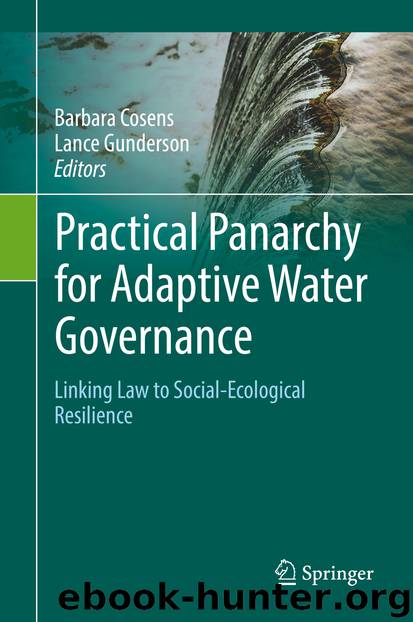Practical Panarchy for Adaptive Water Governance by Barbara Cosens & Lance Gunderson

Author:Barbara Cosens & Lance Gunderson
Language: eng
Format: epub
Publisher: Springer International Publishing, Cham
Capacity
Included under the category of capacity is the ability to navigate ecological regime shifts that has been defined as adaptive capacity (Gunderson 2000) and, of equal importance, the right and resources of interested persons and groups to have a role in decision-making, described here as participatory capacity (Huitema et al. 2009; Raadgever et al. 2008; Pahl-Wostl 2009). In considering the role of law, governmental managers must have the legal authority to experiment and the legal authority to facilitate capacity building among local communities.
Adaptive capacity requires the resources (generally appropriated through a legislative act) and legal authority to respond to change and allows a system of governance to adjust during uncertainty regarding the manner in which change will play out. It is reflected in the statutes, regulations, and practices of agencies (Clarvis et al. 2014). Legal sources effectively define, shape, and limit this capacity in water governance, including through definition of the authority of government to (1) adjust water allocations and water quality requirements in response to change, (2) implement adaptive management in appropriate circumstances (Craig and Ruhl 2014), (3) facilitate collaborative adaptive planning (Arnold 2010, 2014), (4) provide resources and flexibility for local innovation, and (5) facilitate the ability of individuals and private entities to adapt through water markets (Cosens 2016a).
Participatory capacity addresses the right and ability of those affected by water management to participate in the development of its goals. Participatory capacity reduces the likelihood of marginalization of portions of society and increases the likelihood that all aspects of a system will be considered in decision-making. It requires that those affected by water management have the legal right of access to decision-making and the knowledge, time, and resources to engage in the substance of decision-making. The role of law in promoting participatory capacity is to provide the requirement for public participation, judicial forums that can recognize and enforce the rights of those without power, and where appropriate, provide an avenue for capacity building through the legislative allocation of resources and authority to facilitate local response (Olsson et al. 2004; Bingham 2009; National Civic League 2013).
Capacity of both types appears to be the weakest link in the North American water basins. It may be surprising that the wealthiest nation in the world scores so poorly in capacity which focuses on “scientific, technological, organizational, institutional and resource capabilities” (United Nations 1992). However, two legal factors apparent in the basin assessments are relevant here. First, in the context of adaptive capacity, there is currently a lack of legal mechanisms at any level that allow for alternatives to traditional environmental enforcement—alternatives that could enhance local innovation while maintaining stability and accountability toward achieving the goals that traditional enforcement mechanisms seek to achieve. Second, in the context of participatory capacity, federal government has greater resources and participatory capacity than local governments and other governance institutions (with the exception of some economic actors). As a result, when federal legal mechanisms—such as the Endangered Species Act and Clean Water Act—apply in a given basin, the absence
Download
This site does not store any files on its server. We only index and link to content provided by other sites. Please contact the content providers to delete copyright contents if any and email us, we'll remove relevant links or contents immediately.
The Secret History by Donna Tartt(18952)
The Social Justice Warrior Handbook by Lisa De Pasquale(12170)
Thirteen Reasons Why by Jay Asher(8849)
This Is How You Lose Her by Junot Diaz(6839)
Weapons of Math Destruction by Cathy O'Neil(6221)
Zero to One by Peter Thiel(5736)
Beartown by Fredrik Backman(5683)
The Myth of the Strong Leader by Archie Brown(5463)
The Fire Next Time by James Baldwin(5390)
How Democracies Die by Steven Levitsky & Daniel Ziblatt(5175)
Promise Me, Dad by Joe Biden(5117)
Stone's Rules by Roger Stone(5055)
A Higher Loyalty: Truth, Lies, and Leadership by James Comey(4909)
100 Deadly Skills by Clint Emerson(4883)
Rise and Kill First by Ronen Bergman(4741)
Secrecy World by Jake Bernstein(4703)
The David Icke Guide to the Global Conspiracy (and how to end it) by David Icke(4659)
The Farm by Tom Rob Smith(4469)
The Doomsday Machine by Daniel Ellsberg(4453)
